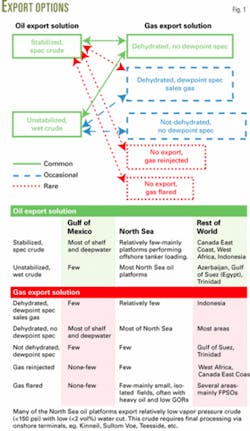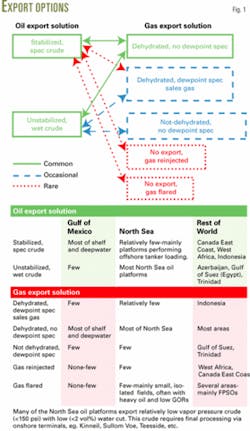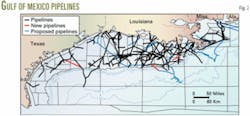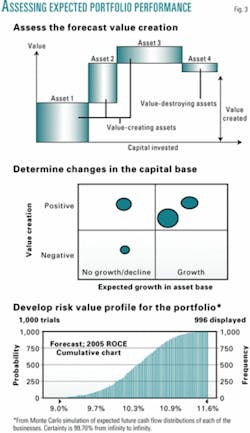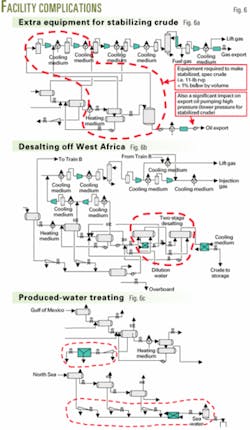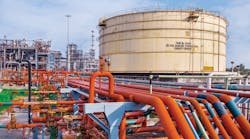Oil projects from different parts of the world provide a reference for the various options available to designers of new offshore processing facilities.
The Gulf of Mexico and North Sea are two of the most prominent producing regions with large, well established offshore production. In such developed offshore regions, the type and proximity of existing infrastructure drives the split between offshore and onshore processing.
But in newer or remote areas, designers have much less clarity as to the split between offshore and onshore processing.
Key aspects of a typical oil platform process flow include:
- Separation equipment.
- Process heating.
- Process cooling.
- Crude dehydration.
- Produced-water treating systems.
- Two vs. three-phase separators.
- Gas-handling compression.
- Gas dehydration
- Gas liquids
- Sour fluids
Offshore processing options
Fig. 1 summarizes the primary processing options on a typical offshore oil platform. These options are defined according to the degree of offshore oil and associated gas processing. Most offshore processing falls into two categories:
1. Stabilized crude within pipeline specifications and dehydrated gas.
2. Unstabilized wet crude and dehydrated gas.
Relatively few oil platforms employ, besides dehydration, additional gas processing, such as hydrocarbon dewpoint control and NGL recovery. Also rarely does an offshore oil platform process both the oil and gas to pipeline specifications because, besides the additional topsides complexity and cost, the handling of intermediate components, such as C4-C5, is difficult.
These components tend to get "caught" between the crude vapor pressure and hydrocarbon dewpoint specifications and can accumulate and recycle in the process until they reach equilibrium. This usually causes problems in the facility, particular for the compression train.
More sophisticated separation may alleviate this problem. If the process needs simultaneously to satisfy crude vapor pressure and hydrocarbon dewpoint specifications, additional separation may include a fractionating column for better control of the disposition of the C4-C5 components. In some cases, the process may require the extraction of a stream rich in C4-C5 for such uses as fuel.
Gulf of Mexico
The most common offshore processing strategy in the Gulf of Mexico provides a stabilized crude within pipeline specifications and an associated gas for export that is dehydrated only with triethylene glycol (TEG).
The oil pipelines in the gulf transport crude typically with an 111-psi rvp or less and a 1% or less bs&w by volume.
The gulf has well developed oil and gas pipeline systems (Fig. 2). Its two main regions are:
1. The shelf that produces from about 4,000 platforms in water shallower than 700 ft. An average shelf platform produces about 10,000 bo/d and 50 MMscfd of gas. Total production is about 500 million bo/d and 9 bscfd of gas.
2. The deepwater that produces from about 40 platforms in water deeper than 1,000 ft. An average deepwater facility produces about 50,000 bo/d and 100 MMscfd of gas. Total production is about 1 million bo/d and 5 bscfd of gas.
Most gulf pipelines are relatively full or near capacity. As a result, new deepwater developments require additional pipelines.
In general, processing in the shelf and deepwater is similar and entails processing crude offshore to pipeline specifications and exporting dehydrated gas ashore for further processing and liquids recovery.
Figs. 3a and 3b show typical process flow diagrams for shelf and deepwater platforms. Although similar, the processes have differences, as Table 1 indicates.
- North Sea
The UK North Sea sector has three main producing regions: Southern North Sea with nearly all gas fields, and the central and northern regions with mostly oil fields and several gas and gas-condensate fields (Fig. 4).
A smaller fourth area, West-of-Shetlands, is primarily oil prone.
In general, North Sea oil platforms do not process crude offshore to its final sales specifications, but typically only to a 150-psia true vapor pressure (TVP) and a 2% bs&w by volume.
Pipelines transport this live, wet crude to an onshore terminal for final processing. In the central and northern regions, these same oil pipelines also transport significant amounts of condensate separated at the gas platforms.
The UK North Sea sector produces about 2 million bo/d and 10 bscfd of gas.
This sector has relatively few onshore oil terminals for receiving and processing the live, wet crude exported from the offshore oil platforms.
Sullom Voe in the Shetland Islands is the only terminal that handles production from the northern region, and three terminals handle production from the central region: Flotta in the Orkney Islands, Kinneil in Scotland, and Teesside in England.
Sullom Voe and Kinneil process 70–80% of the total crude produced in UK North Sea sector.
Similar to the Gulf of Mexico, most associated gas processing usually involves only dehydration with TEG, although several offshore facilities do have hydrocarbon dewpointing and NGL recovery capabilities.
The UK North Sea sector has only a few onshore gas terminals for receiving and processing the offshore gas to the specifications required by the UK gas grid. St. Fergus in Scotland handles gas from both the central and northern fields, while the CATS (Central Area Transmission System) terminal at Teesside handles gas from only the central fields. The three terminals that handle gas produced from the southern fields are: Easington, Theddlethorpe, and Bacton. The Bacton site includes several processing plants.
Bacton, CATS, and St. Fergus handle the bulk of the produced gas.
The UK North Sea has only a few large gas pipeline systems, most of which are designed to operate at dense-phase pressures of 1,600–2,500 psig. Benefits of the dense-phase operations include:
- Improved efficiency for transporting gas over longer distances, especially offshore where intermediate compressor booster stations are not generally feasible.
- Elimination of problems associated with multiphase flow in long, large diameter pipelines.
- Reasonable flexibility with respect to gas composition, such that only dehydration is normally required.
Drawbacks include the need for thicker walled pipe, more expensive pipelines, and additional compression offshore to handle the higher discharge pressures.
Fig. 3c shows a typical processing diagram for central and northern North Sea oil platforms, and Table 1 summarizes the main processing features.
North Sea crude processing
Relatively few offshore facilities in the UK North Sea produce stabilized crude that meets sales specifications. This type of processing is needed mainly in facilities that offload crude to tankers that transport the crude directly to refineries, such as processing facilities on floating production, storage, and offloading (FPSO) vessels. Some fields with FPSO installations include Schiehallion, Foinaven, Norne, Captain, and Gryphon.
The UK North Sea also has a few fixed platforms that offload crude that meets sales specifications to tankers. These platforms include Alba, Harding, and Beryl.
Facilities off Norway have limited access to oil pipelines and onshore processing terminals, and therefore a greater percentage these facilities offload crude oil to tankers. Some facilities with this additional processing capability include Statfjord, Gulfaks, Draugen, Heidrun, and Norne.
Separation equipment
The main factors that influence the number of separation trains on an offshore oil platform are:
- Total flow rate and its effect on vessel sizes.
- Flow complications, particularly the effect of sand, wax, asphaltenes, etc.
- Layout and deck area utilization.
Single separator train designs of up to 150,000–200,000 bo/d are not uncommon. Typical vessels have a maximum 14–16 ft diameter and 80-ft length.
Electrostatic coalescers usually are the largest vessels on new deepwater Gulf of Mexico platforms. These coalescers often have a 12–14 ft diameter and 60–70 ft length.
A platform with more than two parallel separation trains is rare. One example is the Thistle platform in the North Sea with four oil separation trains designed for a nominal 200,000 bo/d total throughput.
Fig. 5a shows the number of separation trains and throughput volumes for various offshore facilities.
The selection of the number of separation stages and stage pressure is a function of:
- Flowing tubing pressure.
- Relative amounts of oil vs. gas.
- Required vapor pressure of the export crude product.
Most Gulf of Mexico oil facilities use five stages of gas-oil separation, including the dry-oil surge tank, while a typical North Sea platform uses two or three stages
Flowing tubing pressure is generally a function of reservoir pressure, well productivity (b/d/psi drawdown), GOR, and water cut.
Fields that produce low crude gravity less than 25°, often have low reservoir pressures, and low GORs, and experience high water cuts later in field life. These factors favor low separation pressures, and therefore fewer separation stages.
Gulf of Mexico platforms can have very high first-stage operating pressures of up to 1,500–1,800 psig. Often GORs for some platform oil wells are greater than 2,000 scf/stock-tank bbl. These high GORs in turn result in high flowing tubing pressures.
Relatively few shelf oil fields include water injection for pressure maintenance. This contributes to high producing GORs.
High GOR and flowing pressure combined with relatively steep well inflow performance (IPR) curves as well as a need to choke wells to limit drawdown and sand production favor a high first-stage separator pressure. The high pressure minimizes power requirements for gas recompression.
On shelf platforms, where gas export pressures are generally low, 1,000–1,200 psig, high-pressure-separator gas often flows directly to the glycol dehydrator and then to sales, bypassing compression.
Several new deepwater oil platforms include fewer separation stages and lower first-stage pressures, primarily to obtain higher production rates by reducing backpressure on wells. These higher production rates more than offset the extra compression costs, in most cases.
North Sea platforms usually have first-stage separator pressures of less than 750 psig because well production is sensitive to backpressure. Also most North Sea fields typically have lower GORs because the projects inject water for pressure maintenance.
The first-stage separation pressure on North Sea oil platforms typically is independent of the gas-export line pressure because this pressure is usually too high for the first-stage separator to "float" on the export line pressure in an attempt to minimize compression power and cost.
High producing GORs will increase the size and cost of gas-handling equipment, in particular compression. The goal then is to separate most gas at a high pressure, balanced against well inflow performance and ultimate hydrocarbon recovery from the reservoir.
As previously discussed, high GOR wells with their higher flowing pressure tend to allow for higher separator pressures.
Because flowing tubing pressure usually will decrease during the life of the field, a common practice is to install separate production manifolds for each separator. In this case, wells with decreased well pressure would be rerouted to a lower pressure separator, thus maximizing production.
The operating pressure and temperature of the final gas-oil separation stage dictates the vapor pressure of the export crude. Generally a stable crude (11 psi rvp) requires a very low pressure and high temperature. A stabilization column that replaces the simple flash-separation stages could achieve this rvp, but these columns are rarely found offshore.
The number of gas-oil separator stages is not the only criterion that impact the decision to export stabilized vs. live crude from a platform.
Fig. 6 illustrates the extra equipment required for stabilizing a crude, and Fig 5b shows the number of separation stages in various offshore facilities.
In the Gulf of Mexico, the normal standard practice is to have two-phase high pressure (1,200–1,600 psig) and intermediate-pressure (450–650 psig) separators with 1-2 min liquid residence times. This sizing criterion is tight and provides limited capacity for handling unsteady flow or foam. Normally, a gulf platform has a three phase, low-pressure separator operating at 150-250 psig for removing most of the water from the produced stream.
Most wells capable of flowing to the high-pressure separator generally do not produce water; therefore a two phase, high-pressure separator is adequate.
The norm in the North Sea is for all separation stages to be three phase. The separators typically have a 3–5 min liquid residence time, which is normally sufficient for light crudes given the high operating separating temperatures and the fact that the exported crude typically can contain 2% water by volume.
These three-phase separators are larger (increased residence time) and heavier (larger size and increased wall thickness). But they also have advantages including:
- Potential for improving the treatment of produced water by reducing the shearing of the oil-water mixture across level control valves.
- Potential for easier emulsion resolution in subsequent stages, again because of the reduced shearing.
- Easier implementation of sand jetting.
- Reduction in size of downstream equipment by removing some of the water earlier in the processing. In particular, if the processing requires heating of the inlet wet crude for emulsion resolution and stabilization, the processing requires less heat if more free water is removed earlier.
Process heating
Facilities normally require heating of the produced fluids only if they produce a stabilized crude that meets pipeline specifications. Exceptions include platforms that receive relatively cool production from remote wellhead platforms or subsea wells and need heat to facilitate separation but not necessarily to produce stabilized crude to pipeline specifications
Heat aids oil-water separation mainly by reducing crude viscosity and aids stabilization by driving off light ends. Besides heating produced fluids, other major processes requiring heating include glycol regeneration and fuel-gas superheating.
Glycol regeneration typically requires the highest temperature, about 400° F.
Nearly all Gulf of Mexico platforms require heat to attain crude-export vapor pressure and bs&w specifications. Typical temperature requirements are about 140–160° F.
North Sea wells tend to flow at much higher temperatures than gulf wells because of their higher reservoir temperatures and flow rates. Because most North Sea platforms do not export stabilized crude that meets sales specifications, the platforms do not normally require heating of the well stream. The relatively few North Sea facilities that offload crude to tankers usually require heating of the flow stream for attaining vapor pressure and water content specifications.
In general, facilities in both the gulf and North Sea use waste heat recovered from the power generation gas-turbine exhaust to heat the well stream. This process typically uses hot oil as the heat medium fluid.
Because maximum temperature requirements are about 400° F. (TEG regeneration), the facilities can use relatively inexpensive mineral oil based fluids for this service, although in some cases facilities use more sophisticated organic fluids. Other heat medium fluids, used occasionally, include hot water or steam that can be operated under pressure at 400° F. to satisfy glycol regeneration requirements and glycol-water mixtures, usually at less than 300° F.
On platforms with relatively low process heating requirements, a process designer can eliminate entirely the heat-medium system and use instead electric-resistance-element heaters for the relatively few and low duty heat loads.
Relatively common on offshore oil platforms is heat recovery via back-exchange, especially when the processing requires a large amount of heat input, such as in the case of a facility handling relatively low-temperature fluids from subsea wells and remote wellhead platforms and requiring relatively high process temperatures for crude dehydration and stabilization.
Both the shelf and deepwater Gulf of Mexico have a fair number of platforms that fall into this category. Also this is common in many other offshore facilities in the world that produce a stabilized crude meeting sales specifications.
This process is not common on North Sea platforms because these facilities typically handle higher temperature well streams and export wet crude. In fact, several North Sea platforms actually cool the oil after the first separation stage.
Back-exchange of hot crude product vs. inlet fluids is most common, although a few facilities also back-exchange separated hot produced water against the inlet fluids. This process uses both shell and tube and gasketed plate-frame heat exchangers, although the experience with plate-frames has been mixed.
Process cooling
The main choices for process cooling are air, direct seawater, and an indirect cooling medium (usually glycol and water). Air cooling is typical on Gulf of Mexico platforms, while direct seawater or an indirect cooling medium prevails on North Sea platforms.
The reasons for this difference include:
- North Sea platforms generally are crowded with little space for air coolers.
- Most North Sea oil projects inject large volumes of seawater for reservoir pressure maintenance, thereby reducing considerably the incremental costs of using water for process cooling.
- Heat exchangers used for water cooling tend to have a much smaller area footprint and are lighter than air coolers.
- The cold North Sea water temperatures help reduce heat-exchanger size and achieve lower process temperatures.
Several gulf deepwater projects use air cooling, but the majority use direct seawater or a glycol-water cooling medium. These projects also have large seawater-injection facilities for pressure maintenance.
Also several projects in the gulf, North Sea, and other regions lift seawater for cooling purposes only and then discharge the water back overboard into the sea. These projects do not have any seawater-injection facilities.
A frequent question is whether to employ direct seawater vs. indirect cooling medium (usually a 30 wt% glycol/water mixture). Operations and maintenance normally favor the indirect system because it reduces the susceptibility to corrosion, scaling, fouling, and hydrate problems associated with seawater. The capital cost of an indirect system normally is somewhat less if the process has a large number of cooling loads and total cooling duty is relatively high.
A relatively clean, non-fouling cooling medium also provides much compatibility with printed-circuit heat exchangers that in some applications can offer significant space and weight savings compared to shell and tube exchangers.
A direct seawater system usually is less expensive and simpler for platforms with relatively few cooling loads and shell and tube heat exchangers, although the system requires upgraded metallurgy.
In the Gulf of Mexico, specifications usually limit crude export temperatures to less than 140° F. If the process back-exchanges the hot crude product against inlet fluids, the facility usually does not require a dedicated crude export cooler. But if the hot crude product is not back exchanged, the facility typically will require a dedicated oil-export cooler whenever the crude stabilization-dehydration temperatures are greater than 140° F.
Although the North Sea typically has higher allowable crude-export temperatures, many of its platforms have crude-export coolers because of high flowing wellhead-separation train operating temperatures. Often the process requires cooling the export crude in order to limit expansion and stress on the crude-export riser. These export crude coolers typically are often direct seawater cooled plate-frame exchangers.
Crude dehydration
In the Gulf of Mexico, 1% bs&w typically meets offshore crude sales specifications. Other parts of the world require crudes with less than 0.5% water by volume, especially if the crude is loaded offshore to tankers.
In either case, the current practice uses liquid-filled electrostatic coalescers for crude dehydration. Improved technology and less conservative designs are some of the reasons vendor designed flux rates for electrostatic coalescers have increased over time. Fluxes of 200 bo/d/sq ft or even higher are now fairly typical for medium and light crude applications.
For light crudes (gravity greater than 35°), a properly sized conventional three-phase separator usually can deliver a crude with a 2% water content by volume, if the flowing wellhead-separation train temperatures are sufficiently high.
For less water content and for heavier oils, the crude dehydration typically will require an electrostatic coalescer, although several North Sea facilities provide crude with less than 0.5% water content (for offshore tanker loading) without electrostatic coalescers.
Gulf of Mexico and North Sea produced crudes rarely require desalting offshore. In general, refineries processing this crude have adequate desalting capability. Desalting in the field is common in other parts of the world, in particular the Middle East, offshore West Africa, and offshore China.
Typical salt content specifications, where applicable, usually range from 10–20 lb of salt (as NaCl)/1,000 bbl of net oil. Depending on the produced water's salinity, the process can achieve this salt specification either with dehydration alone (low produced-water salinity) or with dilution water in single or two-stage desalting arrangements.
Fig. 6b shows the process flow on a West Africa offshore oil platform that uses two-stage desalting.
Produced-water treating
Since the mid–1980s most platforms in the world have used hydrocyclones for the primary produced water cleanup. The typical process places a simple degassing vessel downstream of the hydrocyclones. This still is the most common treating system in the North Sea.
In recent years, an induced gas flotation (IGF) unit has replaced the simple degassing vessel in many parts of the world, including deepwater Gulf of Mexico. This shift was due mainly to the inability of the hydrocyclone-degasser combination consistently to discharge overboard effluent with the required oil-in-water specification, which is about 40–50 ppm by weight (ppmw).
In the Gulf of Mexico, the maximum is 42 ppmw with an average maximum of 29 ppmw.
In the North Sea, the typical hydrocyclone-degasser combination achieves easily the current 40 ppmw specification with many platforms discharging less than 20 ppmw oil-in-water.
Several potential factors cause the difference but perhaps temperature is the most important. North Sea platform processing typically operates at significantly higher temperatures than in other parts of the world.
As previously mentioned, North Sea platforms typically use three-phase separators for all stages, while in the gulf only the low-pressure separator and electrostatic coalescer-treater are typically three-phase. This leads to a considerable difference in the complexity of the produced water treating systems (Fig. 6c). Specifically, the North Sea three-phase separator approach requires a dedicated hydrocyclone package for each separator while the typical gulf two-phase approach requires only one hydrocyclone unit.
The three-phase separation with a dedicated hydrocyclone for the higher pressure stages may reduce the oil-water shear and allow for better produced water treatment. Reduced shear of the oil-water mixture should have the following two major benefits with respect to produced water treating:
1. Lower oil-in-water concentrations due to improved separation in the primary separators. Oil-in-water concentrations from the three-phase separators in a North Sea separation train are typically less than 1,000 ppmw and often less than 500 ppmw.
2. Oil droplets that remain in the produced water generally should be larger in size, which makes them easier to remove with the water treatment equipment.
Reinjection of produced water also is an increasingly common option for produced water disposal, although not yet widely used primarily because of issues related to maintenance of acceptable injectivity into the subsurface formation and compatibility with the seawater normally used for pressure maintenance.
Gas handling
In general, offshore facilities handle gas with centrifugal compressors. These are smaller and lighter than reciprocating compressors, are available in higher capacities and power ratings, and are more compatible with the most commonly used offshore drivers, which are gas turbines and electric motors. Centrifugal compressors also have lower maintenance costs.
The shelf platforms in the Gulf of Mexico as well as other regions where gas volumes are relatively low have used reciprocating compressors extensively. For certain applications such as low-pressure vapor recovery, rotary screw compressors are replacing reciprocating compressors.
Compressor driver selection varies. Larger platforms commonly use high capacity and power centrifugal compressors with gas turbine drivers. Electric motors for drivers combined with a central power-generation facility also is increasingly common and has benefits with respect to availability, platform layout, and environmental emissions. This option is generally more suited to larger facilities.
Small platforms use gas engines for driving reciprocating compressors and pumps.
Most oil platforms, regardless of location, limit gas processing to dehydration only. Most use triethylene glycol units.
Typical water content of the dried gas is 2.5–7 lb /MMscf, depending on pipeline and sales gas contract requirements, or hydrate avoidance requirements. High-pressure gas export combined with low seafloor temperatures often dictate the dehydration requirements.
Most new platforms, due to the higher allowable gas velocities, use structured packing in the glycol contactors to reduce contactor diameter and weight. The installations that must achieve less than 4 lb/MMscf water content normally require the equivalent of three to four theoretical trays in the contactor, in addition to an enhanced regeneration process to achieve more than 99% lean-glycol concentrations.
The industry has had a mixed experience with enhanced regeneration methods such as DRIZO, Coldfinger, etc. The industry has moved away from the historical (and simple) stripping gas process due to emissions concerns, although this method is applicable where the still overhead vapor can be routed to either the suction of a low-pressure vapor recovery unit or to a flare system designed for flare gas recovery.
In general, offshore glycol contactors typically operate at 1,100–1,200 psig. In many offshore regions, this pressure is the same as the gas export line's pressure. In areas where gas export pressures are greater than 2,000 psig, the facilities usually have a final compression stage (export compressor) downstream of the glycol contactor.
Platforms whose gas export pressures are 1,300–1,900 psig typically have the glycol contactor operating at gas export line pressure. Glycol contactors that operate at greater than 2,000 psig exist but are not commonly used.
Several of the new deepwater gulf platforms have two 50% glycol contactors in parallel (common regeneration system), even for single-train designs, although total gas flow rates are typically less than 400 MMscfd. The larger North Sea gas platforms routinely process 500 MMscfd through a single contactor.
Another difference between gulf and North Sea dehydration unit designs is that the gulf units nearly always have a gas-glycol exchanger to achieve the normally recommended difference between the lean glycol and the contactor gas temperature. The North Sea unit, however, typically uses a water (seawater or cooling medium) cooler to cool the lean glycol.
Gas liquids
The recovery offshore of hydrocarbon gas liquids is relatively rare, although platforms equipped with Joule-Thomson expansion, mechanical refrigeration, and turboexpanders for liquids recovery do exist, mainly in the North Sea. A few offshore facilities, such as N' Kossa off West Africa and Ardjuna off Indonesia, also have NGL fractionating columns.
In the Gulf of Mexico, most offshore gas gathering and transmission infrastructure can handle dehydrated but still hydrocarbon-wet gas. Slug catching facilities in shallow water or onshore typically handle the hydrocarbon liquids in the gas. In addition, the low vapor pressure crude specifications generally applicable to gulf production, limit to very small amounts the butane or lighter material in the stabilized crude.
The higher vapor pressure crude specifications typical of offshore North Sea oil platforms allows more light ends in the exported crude, but this normally does not warrant adding more complexity and cost associated with gas liquids recovery schemes. The main exception is if there is a nearby gas pipeline that requires a sales specification for the gas.
Sour fluids
Only a few offshore oil platforms currently process sour fluids (specifically H2S). Several of these platforms are sweetening the produced crude offshore. While H2S-in-crude specifications vary, typical values are often less than 10 ppmw.
A conventional multistage separation process with heating to achieve vapor pressure and water content specifications typically can not achieve a 10 ppmw H2S level in the final crude product unless the H2S concentration in the produced fluids is very low.
Generally the process will require a trayed column with the sour crude fed in at the top and sweet stripping gas introduced at the bottom.
A sweet fuel gas system would normally supply the sweet stripping gas, but this usually would require an amine unit or equivalent for sweetening the sour associated gas separated from the crude.
Fig. 5c indicates the impact of processing decisions on the complexity of the facility.
Based on a presentation to the SPE Annual Technical Conference and Exhibition, Houston, Sept. 26–29, 2004.
The author
Mark Bothamley ([email protected]) is a senior technical consultant with John M. Campbell & Co. Norman, Okla. His experience covers the areas of design, operation, troubleshooting, and optimization of offshore and onshore oil and gas production and treating facilities. Prior to joining JMC, he was with BP-Amoco for 24 years. Bothamley holds a BS in chemical engineering from Lakehead University in Thunder Bay, Ontario, and a diploma in natural gas and petroleum technology from the British Columbia Institute of Technology in Vancouver.
